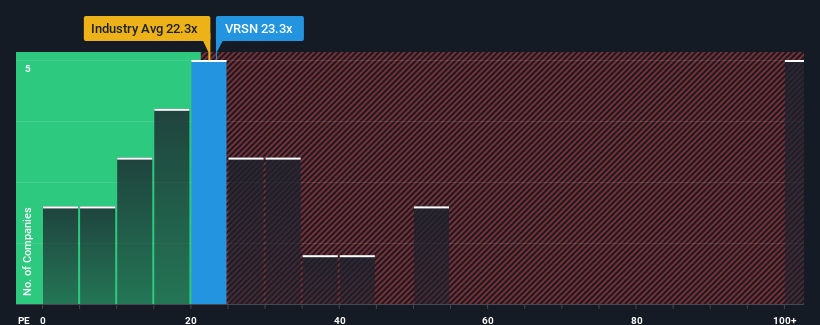- United States
- /
- IT
- /
- NasdaqGS:VRSN
VeriSign, Inc.'s (NASDAQ:VRSN) Business Is Trailing The Market But Its Shares Aren't

VeriSign, Inc.'s (NASDAQ:VRSN) price-to-earnings (or "P/E") ratio of 23.3x might make it look like a sell right now compared to the market in the United States, where around half of the companies have P/E ratios below 16x and even P/E's below 9x are quite common. Although, it's not wise to just take the P/E at face value as there may be an explanation why it's as high as it is.
VeriSign certainly has been doing a good job lately as its earnings growth has been positive while most other companies have been seeing their earnings go backwards. The P/E is probably high because investors think the company will continue to navigate the broader market headwinds better than most. You'd really hope so, otherwise you're paying a pretty hefty price for no particular reason.
Check out our latest analysis for VeriSign

Does Growth Match The High P/E?
There's an inherent assumption that a company should outperform the market for P/E ratios like VeriSign's to be considered reasonable.
If we review the last year of earnings growth, the company posted a terrific increase of 27%. The latest three year period has also seen a 14% overall rise in EPS, aided extensively by its short-term performance. So we can start by confirming that the company has actually done a good job of growing earnings over that time.
Turning to the outlook, the next three years should generate growth of 6.3% per annum as estimated by the four analysts watching the company. Meanwhile, the rest of the market is forecast to expand by 10% per annum, which is noticeably more attractive.
With this information, we find it concerning that VeriSign is trading at a P/E higher than the market. Apparently many investors in the company are way more bullish than analysts indicate and aren't willing to let go of their stock at any price. Only the boldest would assume these prices are sustainable as this level of earnings growth is likely to weigh heavily on the share price eventually.
The Final Word
While the price-to-earnings ratio shouldn't be the defining factor in whether you buy a stock or not, it's quite a capable barometer of earnings expectations.
We've established that VeriSign currently trades on a much higher than expected P/E since its forecast growth is lower than the wider market. When we see a weak earnings outlook with slower than market growth, we suspect the share price is at risk of declining, sending the high P/E lower. This places shareholders' investments at significant risk and potential investors in danger of paying an excessive premium.
And what about other risks? Every company has them, and we've spotted 3 warning signs for VeriSign (of which 1 is significant!) you should know about.
Of course, you might also be able to find a better stock than VeriSign. So you may wish to see this free collection of other companies that have reasonable P/E ratios and have grown earnings strongly.
New: Manage All Your Stock Portfolios in One Place
We've created the ultimate portfolio companion for stock investors, and it's free.
• Connect an unlimited number of Portfolios and see your total in one currency
• Be alerted to new Warning Signs or Risks via email or mobile
• Track the Fair Value of your stocks
Have feedback on this article? Concerned about the content? Get in touch with us directly. Alternatively, email editorial-team (at) simplywallst.com.
This article by Simply Wall St is general in nature. We provide commentary based on historical data and analyst forecasts only using an unbiased methodology and our articles are not intended to be financial advice. It does not constitute a recommendation to buy or sell any stock, and does not take account of your objectives, or your financial situation. We aim to bring you long-term focused analysis driven by fundamental data. Note that our analysis may not factor in the latest price-sensitive company announcements or qualitative material. Simply Wall St has no position in any stocks mentioned.
About NasdaqGS:VRSN
VeriSign
Provides domain name registry services and internet infrastructure that enables internet navigation for various recognized domain names worldwide.
Solid track record and fair value.

